|
The Grumman Wildcat
in FAA Service
by Bruce
Archer
|
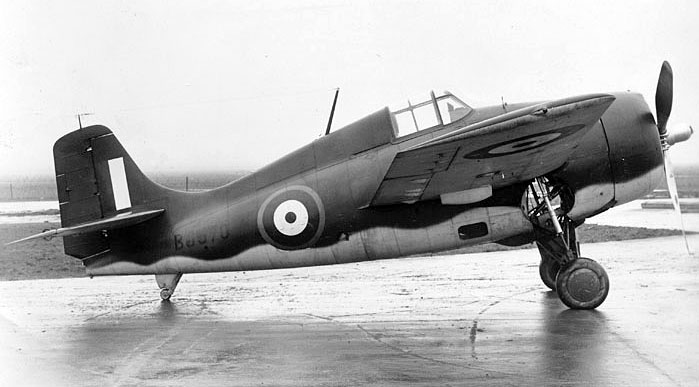 |
|
Martlet I BJ570. This view shows
the spotting features of the Martlet I. Short chord Cyclone cowl with no
cowl flaps, carburetor intake at the 12 o’clock position and the
Hamilton Standard Hydromatic prop. Note the ring site on the forward
decking. The bead site was located on the cockpit combing inside the
windscreen. Also note the prop is polished aluminum on the front face
and flat black on the rear face. This aircraft is probably painted in
Extra Dark Sea Grey, Dark Slate Grey (of American manufacture) paint and
a light blue shade of Sky. Copyright is unknown. |
I really do not know why, but I always seem to take on very
confusing subjects. Spitfires, for example can and will make your head hurt with
the variations between aircraft of the same Mark, let alone the differing Marks.
The Grumman F4F Wildcat/Martlet appeared to be no different. For what is
supposedly a simple aircraft there are so many variables it appeared even the
Admiralty gave up on giving coherent Mark numbers to the Martlet. This article
hopes to clarify the apparent confusing Marks, sub-marks and confusing serials
of the Martlet/Wildcat in the FAA.
In 1939, the FAA was not ready
to fight a war. With no Bureau of Aeronautics (BuAer) like the USN, and only
recently getting their Air Arm back from the RAF, the FAA was straddled with a
series of obsolete or close to being obsolete aircraft (such as the Skua, and
Sea Gladiator). Though the US Navy was still using bi-planes, the winds of
change were apparent. The F2A, TBD, SBD, F4F and SB2U monoplanes were all in
development or were in squadron service. Japan, the third naval air power was
developing the Zero fighter, the Kate torpedo bomber and the Val dive-bomber.
The newest fighter the FAA had was the Blackburn Roc. In addition, the FAA
persisted in the outmoded thinking that you needed a second seat in naval
fighters, which led to heavy, slow fighters (the Fulmar and Firefly). With the
Sea Hurricane (not really suitable as a carrier fighter) and the Seafire (not at
all suitable) a couple of years away the Royal Navy needed aircraft. With the
war raging, the British Purchasing Commission was given a blank check and sent
looking for aircraft. The Martlet and Wildcat was one type chosen.
With the war in Europe, France approached Grumman in October of 1939 for
Wildcats for their two carriers which were under construction (Reference 3). The
only engine that was approved, for export by the US Government was the Wright
R-1820 Cyclone . This was fitted into the G-36A (as the Wildcat was known by
Grumman), the flight tests were successful and machines started down the line.
However, France fell before the aircraft production was completed and delivered.
The British Purchasing Commission (BPC) quickly acquired these planes for the
FAA deliveries starting in July of 1940 (Reference 3). Martlet I, II, III and
Wildcat IV, V, and VI were built for the FAA in substantial numbers. At the end
of the war, the FAA was the second largest user of the Wildcat, with an apparent
bewildering array of versions.
|
Grumman Wildcat / Martlet Variants in FAA
Service |
Martlet Mark I (see title image)
The Martlet Mark I was aircraft originally ordered by
France and Belgium. The Belgians ordered Martlets (Reference 10) which,
according to Grumman records, were absorbed into the French order when Belgium
fell. The Martlet (G-36A) was from the these two orders, which could not
be delivered because of the fall of France.
Martlet Is came equipped with a Wright R-1820-G205A Cyclone
engine with a single-stage, two-speed supercharger. The Cyclone was shorter than
the Twin Wasp so the cowl was shorter in chord and did not have any cowl flaps,
and with the overall length being the same (approximate) length as a Wildcat
with a Pratt and Whitney engine, the distance between the wing and rear of the
cowl was longer. This is true of all Cyclone powered Martlets/Wildcats. With the
Mk.I, this distance was 22 inches (as measured on the FAA Museum’s sole
surviving Mk.I). It has to be mentioned here, that the single row Cyclone had
either baffle plates or air intakes between the cylinders. This forced air over
the cooling fins and cooled the engine more efficiently. All single row radials
in a cowl were configured like this. The twin row Twin Wasp did not need the
baffles for cooling.
All Martlet Mk.Is had the F4F-3 straight pitot tube and a
Hamilton Standard Hydro-matic uncuffed prop. Mk.Is had fixed wings and 4 wing
guns, 46” and 117” from the centerline of the fuselage with 430 rounds per gun.
Otherwise, these Martlets were similar to F4F-3Bs.
Contrary to popular belief Martlet Is did go to sea.
They were equipped with hooks, but the holdback was not fitted. Serials included
AL231-AL262, AX824-AX829, BJ507-BJ527, and BJ554-BJ570.
Lost at sea whilst being delivered were Martlet I serials
BT447-BT456 (Reference 10, 11).
Martlet Mark II
The Martlet II was the first Martlet actually ordered by
the British Purchasing Commission for the FAA. The contract was for 100 F4F-4A
equivalent aircraft with folding wings and 3 guns per wing with 240 rounds per
gun. The first ten Mk.IIs were delivered to F4F-3 standards with fixed wings and
4 wing guns. These 10, Serials AM954 to AM963 were redesignated as
Mark IIIs (References 2,4,7,8,10,11). These are covered in the Mark III
section. The remaining Mark IIs were differentiated by the pitot tubes. AM964
to AM 999 had a unique pitot. This pitot was located on the port upper
wing, near the inner edge of the aileron. This pitot angled to the rear and
upwards. These aircraft were the only Wildcat/Martlet to use this pitot. The
remaining Mark IIs, serial range AJ100 to AJ153 used the standard
F4F-4 pitot.
|
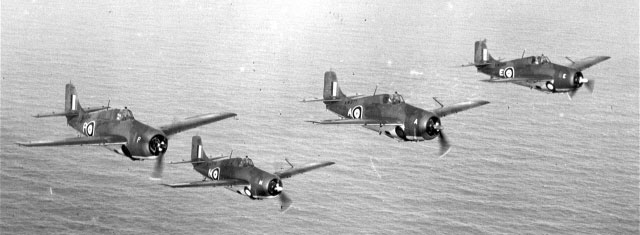 |
|
Martlet II, AJ104 “P”, AM976 “N”,
AM977 “A”, and AMxxx “E” of No. 880 Sqn, HMS Formidable in 1942. This
image shows the spotting features of the Martlet II and the major
difference between the two series of Martlet II. Note the lack of
carburetor intake on the cowl, the lack of intercooler scoops, the 6-gun
folding wings, wide chord Pratt and Whitney cowl with one cowl flap per
side and the Curtiss Electric prop with a pointed hub. AJ 104 has the
F4F-4 style pitot and the three AMxxx serialed Martlets have the unique
pitot over the port wing. All appear to be painted in Extra Dark Sea
Grey, Dark Slate Grey and Sky. The codes appear to be in either sky or
white. “P” and “A” have a painted spinner (“P” in red?) and colored
wheel hubs. Possibly, the wheels are in the spinner’s color. “N” and “E”
have sky colored wheel hubs, and unpainted spinners. Imperial War
Museum, via the Smithsonian Institution. |
The Martlet II (from this point onwards, I am not speaking
of the first 10 Mk.IIs which became Mk.IIIs) were powered by a Pratt and Whitney
R-1830-90 Twin Wasp single stage two speed supercharged radial. This engine had
the magnetos on the rear of the engine, next to the carburetor. The cowl was the
standard chord Pratt and Whitney cowl, which had one large cowl flap on each
side. The distance from the wing leading edge to the rear of the cowl is 14 5/8
inches on all Pratt and Whitney powered Martlets/Wildcats. The cowl did not
have the carb intake on the top, and the intercooler scoops were deleted. The
propeller was a cuffed Curtiss Electric three blade, with a domed (similar to
the dome found on P-43s and P-47s with Curtiss props) hub. All had folding wings
with 3 guns per wing and had 240 rounds per gun. Some aircraft in the AM serial
range had an extended lower fairing, which may have had something to do with the
fuel system; AJ series aircraft did not have this extension. Serials for Martlet
Mk.II are AM964-AM999 and AJ100-AJ153. Aircraft lost at sea whilst
being delivered were AM954, AJ105, AJ106, AJ138-AJ145, and
AJ124-AJ126.
|
 |
|
Martlet II AJ148, 7A-0 No. 888
Sqn., Oran Algeria, 1942. This view shows the wide chord Pratt and
Whitney cowl with the two cowl flaps (one per side). Note the F4F-4
style pitot in which all AJxxx serialed Martlet IIs were equipped. Also,
note lack of carburetor intake. Official US Navy Photo. |
Martlet Mark III
The Martlet Mark III has been the bane of Martlet builders
for a long time. However I feel I have cut through the bad information and have
finally figured out the convoluted quagmire know as the Martlet Mk.III.
First, it has been documented that the first ten Martlet
Mk.IIs (AM954-AM963) were built to F4F-3 standards with fixed wings and
were originally to be converted to have folding wings. However, I have found no
evidence this happened. As they were not similar to the Martlet Mk.II
(different Pratt and Whitney Twin Wasp, fixed wings and 4 wing guns) they were
correctly redesignated as Mk.IIIs. Why was this done? They were very similar to
the 30 ex-Greek F4F-3As that the FAA acquired when Greece fell. These ex-Mk.
IIs were powered by a Pratt and Whitney R-1830-76 Twin Wasp with a two-speed
two-stage supercharger. The wings were fixed with a straight pitot and had 4
wing guns with 430 rounds per gun. All had the carb scoop and the intercooler
scoops. These also had one cowl flap per side and a Curtiss Electric cuffed
propeller with a domed prop hub.
The next Mark IIIs were the 30 ex-Greek Martlets that the FAA acquired when
Greece fell. These originally kept their BuAer Nos. 3875 to 3904.
More about these Martlet serials later. These were the first 30 F4F-3A Wildcats/Martlets
built. They were powered with a Pratt and Whitney R-1830-90 Twin Wasp, which had
a single stage two-speed supercharger. The cowl was a standard Pratt and Whitney
cowl with the carb scoop at the top of the cowl but no intercooler scoops. The
cowl had one cowl flap per side. The propeller was a Curtiss Electric three
blade with cuffs and a stepped prop hub. The wings were fixed, with a straight
pitot, 4 wing guns and 430 rounds per gun.
The ex-Greek Martlets is where
the confusion with serials and numbers of aircraft have resulted. It seems
previous authors have added approximately 36 aircraft which do not exist. I
have confirmed only 40 Martlet IIIs. These include the first Mark IIs, and the
Greek order. The reason for the confusion was the way the Greek F4F-3As received
serials. Local air depots were assigned serials for locally acquired aircraft.
Here is where the confusion started. The local air depot assigned serials
AX725-AX747, AX753-AX754, AX761, AX824-AX829 and
HK841-HK842, (a total of 36 serials) (references 4, 8, 10, 12). The problem
is some of these serials were not used. Known BuAer numbers and a correlation
with British serials are shown on Table Number 2.
|
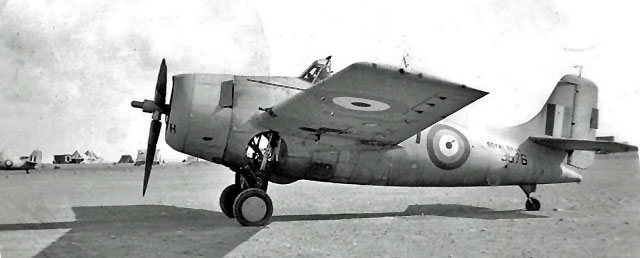 |
|
Martlet III 3876 (FAA Serial
AX746) “H” of 805 Sqn. This aircraft is from the ex-Greek order. Note
the fixed wings, and 4 wing guns. Note the Curtiss Electric prop with a
stepped hub, wide chord Pratt and Whitney cowl with one cowl flap per
side, and the F4F-3 type pitot. Missing are the intercooler intakes.
This aircraft is in its delivery scheme of Non-Specular Light Grey (USN).
In addition, the photographer used ortho film. The AMxxx serialed
Martlet III were F4F-3 aircraft. The ex-Greek order were F4F-3A
aircraft. Copyright is unknown. |
Wildcat Mark IV
These aircraft were supplied under Lend-Lease, and were the
last Wildcats built for the FAA by Grumman, and the first to be called Wildcats.
The Mk.IV reverted to the Wright R-1820-40 Cyclone
with a single speed, two-stage supercharger. Why this change was made, I
do not know. However, it was equipped with a short chord cowl with one small
cowl flap on either side. All of the scoops for the intercooler and carburetor
were moved to in-between the cylinders. A Hamilton Standard Hydromatic uncuffed
propeller was used. All Mk.IVs had folding, 6 gun wings with 240 rounds per gun.
All had the F4F-4 style pitot. These were equivalent to the F4F-4B. The serials
assigned were FN100 to FN319. Wildcat IV lost at sea whilst being
delivered were FN205-FN207 and FN240-FN241 (Reference 10, 11).
|
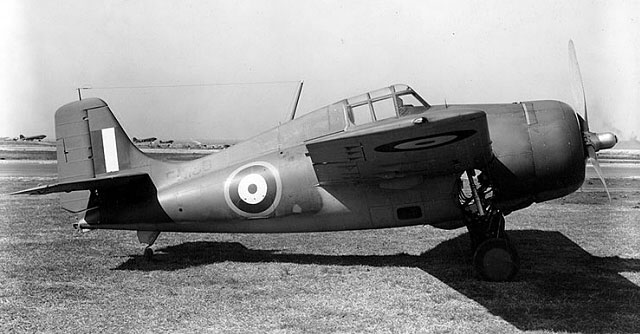 |
|
Martlet (Wildcat) IV FNx80 at NAS
Anacostia. The Mk.IV has a short chord Cyclone cowl with one flap per
side, Hamilton Standard Hydromatic prop, six gun folding wings and a
F4F-4 pitot. Note what appears to be a ring sight on top of the front
fuselage decking. This is the last mark of Wildcat built by Grumman for
the FAA. The aircraft appears to be finished in Extra Dark Sea Grey,
Dark Slate Grey and Sky. Official US Navy Photograph. |
Wildcat Mark V
The Wildcat V was the first Wildcat produced by Eastern
Aircraft for the FAA. All were delivered under Lend-Lease. These were FM-1s, a
F4F-4 with 4 wing guns. All were powered by a Pratt and Whitney R-1830-86 Twin
Wasp with a two-speed, two-stage supercharger and had a Curtiss Electric cuffed
propeller with a stepped hub. The cowl was the longer Pratt and Whitney style,
with both the carburetor and intercooler scoops. There were 4 small cowl flaps
per side. Wings were folding but the Mk.V/FM-1 reverted to 4 wing guns with 430
rounds per gun. The pitot was the F4F-4 style. Serials ranged from
JV325-JV636.
|
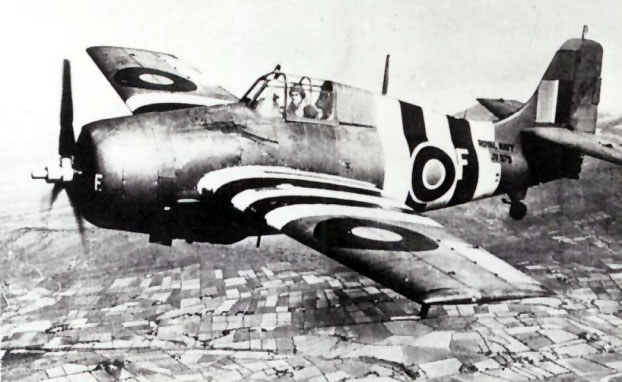 |
|
Wildcat V JV578 “F” of 852 Sqn in
June or July 1944. Though the quality of image is not as good as in
previous images, it is still useful. The aircraft is very similar to a
F4F-4, but with 4 gun wings, the outer guns being deleted. Note the
vertical radio mast, not canted as in previous versions. JV578 has the
long chord Pratt and Whitney cowl with the intercooler scoops,
carburetor intake and 4 cowl flaps per side. It appears the ring and
bead sights had been deleted. A Curtiss Electric prop with a stepped hub
was fitted. Though early FM-1s (Wildcat V) were painted as were the
Grumman built aircraft, this aircraft is most likely in the US
“equivalent” scheme of Olive Drab and Sea (US) Grey with Light Grey (USN
Non-Specular Light Grey) undersides. This was the first version of the
Wildcat built by Eastern Aircraft for the FAA. Copyright is Unknown. |
Wildcat
Mark VI
The Wildcat VI, a FM-2, was an attempt to improve the
performance of the Wildcat. A Wright R-1820-56 Cyclone with a single speed,
two-stage supercharger was fitted and had an additional 150 horsepower over
previous versions. A Curtiss Electric propeller without cuffs was fitted and
could have either a domed or a stepped hub. The cowl had a longer chord than the
Mk.I and IV, but was shorter than the Pratt & Whitney cowl. There were no
external scoops on the cowl; all of the scoops were between the cylinders. The
cowl had one cowl flap per side. The exhausts were routed out a cutout on the
fuselage (one per side) and out the bottom. The oil coolers were removed from
the lower wings and moved into the accessory bay. The wings were folding and had
4 guns with 430 rounds per gun. To counter the added torque of the new engine,
the fin and rudder were enlarged. In addition, the windows on the underside of
the airframe were deleted. Serials ranged from JV637-JV902,
JW785-JW836 and JZ860-JZ889.
|
 |
|
USN FM-2 Wildcat from the USS
Santee in October 1944. A nice air to air study of the FM-2. Note the
medium chord Cyclone cowl, with one cowl flap per side and the exhaust
cut outs. Also seen is the two gun folding wings and tall tail of this
version. The FM-2 was equipped with a Curtiss Electric Prop with either
the stepped hub (as seen here) or a pointed hub. The radio mast was
vertical. No carburetor intake on the cowl, nor were there the
intercooler intakes. The carburetor intakes were moved to in between the
cylinders. Though this aircraft is not a FAA Wildcat VI, the outer
appearance was not changed from USN FM-2s. Wildcat VIs were delivered in
either Olive Drab, Sea Grey, Light Grey camouflage, or in overall Glossy
Sea blue. Official US Navy photograph. |
There were five camouflage schemes worn by the Martlet/Wildcat
in FAA service. All of these schemes are manufacturer-dependant and will be
discussed by manufacturer. Remember these are “as delivered” schemes and the
aircraft may have been repainted by the FAA at some time.
Grumman
Grumman was one of the few manufacturers, perhaps the only
US manufacturer to get the FAA’s temperate Sea Scheme correct. With the
exception of the first Martlet Is, Grumman used US manufactured colors that were
very close, if not matches to Extra Dark Sea Grey, Dark Slate Grey and Sky. The
sky at times had a blueish tint to it though. The first Martlet Is were painted
very differently. The uppers were painted in Extra Dark Sea Grey, Light Sea
Green and Duck Egg Blue. The exact shade of these colors is still under debate
today. Later Martlet I deliveries appear they may have been painted in the
correct colors. Alternatively, these may have been FAA repaints. The ex-Greek
Martlet IIIs were delivered in overall USN Non-Specular Light Grey, and most
soon acquired a coat of camouflage color(s) on the upper surface. Most received
a Mid Stone upper surface, but there are images which show a two color upper
surface, and at least one aircraft received a dark undersurface. All Grumman
Martlet/Wildcat interiors were Bronze Green (close to FS24050 or 20452), and the
majority of the remaining interior was painted in “Grumman Grey” This is close
to FS6440. This included the cowl’s interior. The fuel tank was either aluminum
of a dull steel color. The lower parts of the landing gear was a heat resistant
black, the remainder could be either Grumman Grey or Sky. The notches where the
wheel sat was in the underside color. Areas, which were out of sight, were in
Zinc Chromate Yellow or Grumman Grey. Props were either polished aluminum with
USN stripes, or black with 4” yellow tips. The wheel hubs were the underside
color on the outer cover and aluminum on the inner.
Eastern Aircraft
Eastern Aircraft took over the manufacture of the Wildcat from Grumman as
Grumman was busy making Hellcats. The Wildcat was manufactured in Linden, NJ
(near my home) and towed across the street to the Linden Airport for test flying
and delivery. The first Eastern built Wildcats for the FAA, the Mk.V, may have
worn two schemes. The first off the line are reportedly were painted according
to Grumman specs, which include the primers, interior color and the correct
shades for the Temperate Sea Scheme. However, the majority of Mk.Vs (FM-1s) were
painted in the US ANA substitute colors of Olive Drab, Sea Grey and Light Grey.
The cockpit was in “Interior Green”, and the remainder of the primed surfaces
was in Zinc Chromate, either green or yellow.
The Wildcat VI was painted in two differing schemes. The first was in the US ANA
Substitute Scheme of Olive Drab, Sea Grey and Light Grey. The Interior and
primed areas of the aircraft were as above. The second scheme was overall Glossy
Sea Blue, with a Non-Specular Sea Blue anti-glare panel. An Eastern Aircraft
painter (reference 12) interviewed by me stated that the Non-Specular Sea Blue
was used initially because Eastern had quite a bit of this color in stock. When
stocks of the Non-Specular Sea Blue were exhausted, a flat varnish was used to
paint the anti-glare panel. The cockpit and interior were like the late Wildcat
Vs.
I want to extend special thanks to my wife, the lovely and de-liteful Dana for
putting up with me, to Joe Lyons for keeping me focused, Steve Eisenman who
furnished me with the postings I was missing from the old FAASIG (US), to the
members of the old FAASIG US, and the FAASIG UK for the help they have given me,
and to the Southern New Jersey Scale Modelers who allow their President to rant
on and on about not only Martlets but Spitfires as well. My thanks to all!
Table1: Martlet Variants and Characteristics
|
|
Mk.I |
Mk.II
|
Mk.II |
Mk.III |
Mk.III |
Mk.IV |
Mk.V |
Mk.VI |
|
Serials |
Al231-AL262;
AX824-AX829; BJ507-BJ527; BJ554-BJ570 |
AM964-AM999 |
AJ100-AJ153 |
AM954-AM963 |
AX725-AX747;
AX753-AX754; AX761; AX824-AX829; HK841-HK842 |
FN100-FN319 |
JV325-JV636 |
JV637-JV902;
JW785-JW836**; JZ860-JZ889** |
|
USN Equivalent |
None* |
F4F-4A |
F4F-4A |
F4F-3 |
F4F-3A |
F4F-4B |
FM-1 |
FM-2 |
|
Engine |
Wright
R-1820-G205 Cyclone |
Pratt & Whitney
R-1830-90 Twin Wasp |
Pratt & Whitney
R-1830-90 Twin Wasp |
Pratt & Whitney
R-1830-76 Twin Wasp |
Pratt & Whitney
R-1830-90 Twin Wasp |
Wright
R-1820-40 Cyclone |
Pratt & Whitney
R-1830-86 Twin Wasp |
Wright
R-1820-56 Cyclone |
|
Supercharger |
Single Stage-
two Speed |
Single Stage-
two Speed |
Single Stage-
two Speed |
Two Stage- Two
Speed |
Single Stage-
two Speed |
Single Stage-
two Speed |
Two Stage- Two
Speed |
Single Stage-
two Speed |
|
Cowl |
Short |
Long |
Long |
Long |
Long |
Short |
Long |
Unique |
|
Cowl Flaps Per
Side |
None |
1 |
1 |
1 |
1 |
1 |
4 |
1 |
|
Carb Scoop on
Top? |
Yes |
No |
No |
Yes |
Yes |
No |
Yes |
No |
|
Intercooler
Scoops? |
No |
No |
No |
Yes |
No |
No |
Yes |
No |
|
Propeller |
Ham. Std. |
Curtiss |
Curtiss |
Curtiss |
Curtiss |
Ham. Std. |
Curtiss |
Curtiss |
|
Prop Hub |
Domed |
Domed |
Domed |
Domed |
Stepped |
Domed |
Stepped |
Either |
|
Cuffed? |
No |
Yes |
Yes |
Yes |
Yes |
No |
Yes |
Either |
|
Wings |
Fixed |
Folding |
Folding |
Fixed |
Fixed |
Folding |
Folding |
Folding |
|
No. of Guns |
4 |
6 |
6 |
4 |
4 |
6 |
4 |
4 |
|
Rounds per Gun |
430 |
240 |
240 |
430 |
430 |
240 |
430 |
430 |
|
Pitot |
F4F-3 Type |
Unique |
F4F-4 Type |
F4F-3 Type |
F4F-3 Type |
F4F-4 Type |
F4F-4 Type |
F4F-4 Type |
|
Source |
French |
BPC |
BPC |
BPC |
Greece |
Lend-Lease |
Lend-Lease |
Lend-Lease |
|
Lost at Sea |
BT447-BT456 |
AM954 |
AJ105-AJ106;
AJ138-AJ145; AJ124-AJ126 |
None |
None |
FN205-FN207;
FN240-FN241 |
None |
None |
*= The closest US Equivalent would be the F4F-3B
**= These serials may not have been delivered
Table No. 2 Ex-Greek Martlet III Serials
|
BuAer
No. |
FAA
Serial |
BuAer
No. |
FAA
Serial |
|
3875 |
AX727 |
3893 |
Unknown |
|
3876 |
AX746 |
3894 |
AX743 |
|
3878 |
AX738 |
3896 |
Unknown |
|
3879 |
AX725 |
3898 |
Unknown |
|
3880 |
AX735 |
3899 |
AX754 |
|
3881 |
AX731 |
3900 |
AX744 |
|
3882 |
AX733 |
3901 |
AX745 |
|
3883 |
AX734 |
3902 |
AX747 |
|
3884 |
AX728 |
3903 |
AX736 |
|
3885 |
AX726 |
3904 |
AX753 |
|
3886 |
AX730 |
3877(?) |
AX761 |
|
3888 |
AX742 |
3887
or 3897 |
AX737 |
|
3889 |
AX729 |
3887
(3897?) |
AX741 |
|
3890 |
AX724 |
Unknown |
AX739 |
|
3891 |
AX732 |
Unknown |
AX740 |
|
3892 |
Unknown |
Unknown |
HK840 |
|
|
|
Unknown |
HK841 |
(References 4,10,11)
1
F4F Wildcat in Action, Squadron/Signal Publications-2004
2
Warpaint No.9- Grumman F4F Wildcat. Hall Park Books Ltd.-1997(?)
3
In Detail and Scale No.65, F4F Wildcat. Squadron Signal Publications-2000
4
Air Arsenal North America, Pages 210-211
5
The Grumman Martlet, by Wesley Moore, IPMS Update, date unknown
6
Nine Lives by Brian Derbyshire. IPMS UK, date unknown
7
The Martlet and Wildcat by Scott Spencer, FAA SIG website, both US and UK
8
Aircraft of the FAA 1939-1945, Air Britain
9
Dana Bell’s Aviation Color Primers- No.1: US Export Colors of WWII,
Meteor Productions - 2002
10
Discussion Board Postings FAA SIG (US and UK)
11
E-Mail conversations with Dave Fleming, Claudio Narduzzi, Jim Bates,
Roger Andrews, and Terry McGradey
12
Conversation with Dale Peters, painter with Eastern Aircraft, Linden
Plant 1943-1945
13
The Fleet Air Arm Museum’s Martlet Mk.I , serial No. AL 246
14
Mr. Russell Lee, Curator The National Air and Space Museum, who supplied
information on the Museum’s FM-1 Wildcat
Text & Images Copyright ©
2006 by Bruce Archer
Page Created 06 March, 2006
Last Updated
06 March, 2006
Back to Reference Library
|
Home |
What's New |
Features |
Gallery |
Reviews |
Reference |
Forum |
Search